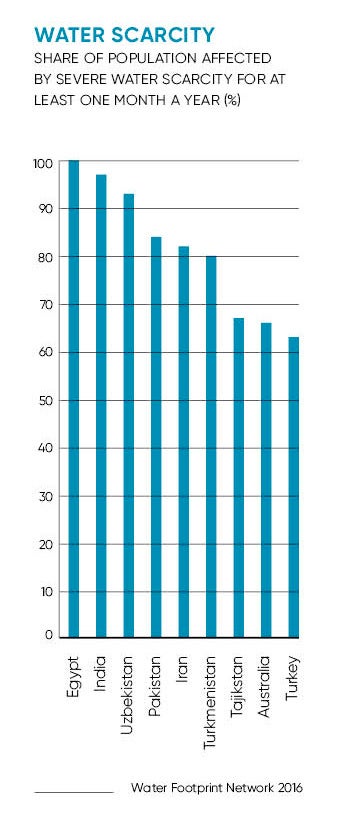Fog-catcher nets help some of the poorest people in Peru’s capital Lima harvest water from the moist air for cooking and irrigation. In the desert landscape of Arizona, a solar-powered device can successfully extract fresh water from the arid atmosphere.
Elsewhere smart metering and sensors provide water utilities with more real-time data on how water systems are working in cities and towns.
Do we now have the technology to end the plight of two billion people who, according to the United Nations, live in areas of water scarcity?
 “Though there are always ways of improving and making things cheaper, fundamentally we already have everything we need,” says Giulio Boccaletti, chief strategy officer and managing director, water, at the Nature Conservancy. “But water is rarely an issue of technology.”
“Though there are always ways of improving and making things cheaper, fundamentally we already have everything we need,” says Giulio Boccaletti, chief strategy officer and managing director, water, at the Nature Conservancy. “But water is rarely an issue of technology.”
Universal metering in the UK could reduce household water consumption by as much as 10 to 15 per cent, says Dragan Savic, professor of hydroinformatics at the University of Exeter, but expanding this simple technology requires significant investment by water companies that may then face public resistance.
The relationship with water often found in developed nations needs to change. Consumers are unwilling to pay more and are unaware of the situation with water resources in their country, impeding an already fairly invisible water industry.
Technology could help change this; smart metering can provide consumers with more instant feedback on water consumption, for example.
The story of water is often that the underlying costs of the infrastructure or technology can’t be borne solely by the products we get from it
To encourage wider adoption of emerging water technologies that involve big data and analytics, different industry roles and skills are needed.
“The water industry has to have people who understand these new devices; people who understand sensors and how information can be converted into knowledge,” says Professor Savic, who is also director of the Water Informatics Science Engineering Centre for Doctoral Training.
“In the UK we have just two professional training centres. We have to move much faster with larger numbers of young people who can lead the water industry into the 21st century.”
Scaling technology and changing water systems in most countries is not possible without input from properly equipped local government. “They are responsible for making sure people have access to water services. They need to be invested and have the capacity to do the work,” says Marieke Adank, programme officer at IRC.
Smart technology cannot work in isolation; a response to the data is needed. It is possible, for example, for hand pumps in communities in Africa to communicate when they are broken thanks to the installation of sensors, but this information must go to someone who is capable of fixing the broken pump.
Scaling all types of water technology requires a tandem financial and institutional response and by far the biggest barrier to technology adoption in the water industry and water-intensive industries is cost, whether that’s the money involved in upgrading an entire network of water pipes or in setting up a drip irrigation system for acres of crops.
If the agriculture sector bore the full cost of irrigation or efficient irrigation, for example, food prices would go up, says Mr Boccaletti.
“The story of water is often that the underlying costs of the infrastructure or technology can’t be borne solely by the products we get from it,” he says.
Public-private partnerships can help, bringing private capital and capacity to previously, and possibly poorly, publicly managed water systems. This is already happening in places such as Ghana, where a company manages the reporting of broken hand pumps and ordering new parts by SMS. Technology is a small part of this, and such partnerships will only work if the public sector has the capacity and ability to engage the private sector, says Ms Adank.
Ultimately, water is not a high-tech business, Mr Boccaletti concludes: “This is not Tesla. The story of water has been the same for 2,000 years – the marginal value we place on the stuff is not enough to pay for the infrastructure in the first place.”

